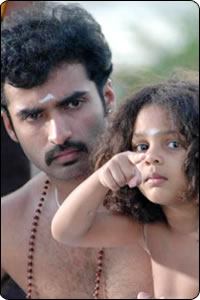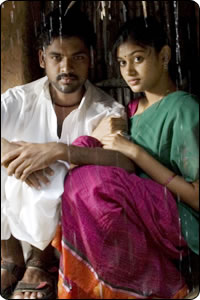|  |
AV revolves around an ancestral house in Ananthapuram, which has remained uninhabited for several years owing to the sudden demise of a couple in an accident. Their son Bala (Nandha), who is running his own leather business in Chennai, comes to the property after 15 years with his wife Revathy (Chaya Singh) and his small boy Ananth (Aryan). Very soon, unexplained incidents happen in the house which makes Revathy, a claustrophobic, wanting to get out of the house. However, Bala does not believe in her and dismisses the events as sheer coincidences. It was their son Ananth, a speech impaired child who discovers the abnormal activities around the house but unable to comprehend and convey.
The factor in which AV stands out is the spirits are well meaning ones and are that of Bala’s parents. They always help the inmates of the house. At a time when films dealing with paranormal activity or supernatural powers are all evil ones and sends Goosebumps or shiver down your spine, AV comes as a fresh whiff of air and within twenty minutes of the film, the audiences are relaxed that they are not going to be subjected to some creepy ride. Nevertheless at this juncture, the director places a mysterious situation involving the hero and his business partner Jeeva who comes to the town to discuss a financial problem with Bala. Revathy comes to know that her husband is in serious mess in his business and that they are stuck at the house unless Bala returns money that he has borrowed from a few people. The answers to questions like whether Bala was able to return the money and if so how, what do the spirits do and who is the actual culprit in his misadventure are found in the rest of AV.
It was initially surprising to see a U certificate for a horror flick. But as the film unfolds, the reasons become lucid. Naga must be credited with giving a clean family flick in his debut vehicle. The moment we realize the spirits are good ones, we start enjoying their antics. The sequences where the spirits take care of cooking to cleaning to healing are enjoyable and women would certainly want to lease such kind of spirits to help them in their daily chores.
The kid Aryan is a revelation, reminds a lot of young version of Sachin Tendulkar. With his unruly curly mane and apt expressions, he captivates the hearts. Chaya Singh appears in Kollywood after Vallamai Thaaraayo and is adequate. However, it was Nanda who misses many a chance to prove his acting prowess. He remains contrived mostly. Kalaivani, as the governess of the house, is decent. Nandha’s friend Jeeva who was seen in K Balachander’s serial Sahana has delivered it right.
Technically, AV cannot boast much because there is not much scope for it and the team has also not attempted for it. Cinematography by Arun Mani Palani is in sync with the theme and there are just two songs and music scored by Ramesh Krishna does not stay in the minds. Most of the film is shot within the house and CG work is just average.
Although AV has a couple of pluses to its credit, it lacks in pace and there is an uneven keel to it. The narration does not engage the audience which is much needed for a film like this. AV does not scare you at all and is right for people wanting a relaxed family fare.
Verdict: No scare, this haunted house!
|  |
It is a love story set against the backdrop of India that is on the verge of independence. A young British lady (Amy Jackson) is visiting India. She is from a family that is well connected to the highest echelons of power in the Madras presidency. As it is, tensions are brewing between the British and Indians all over the country. That rubs off on a small washer man community in Madras who stand in the way of the powerful British personnel when they attempt to evict them from their place. It hurts the ego of a highly placed British officer who challenges a young dhobi (Arya) for a one-on-one which would decide the fate of the place. The British lady happens to be a silent spectator to all that transpires between the British and the dhobi community; she notices the young man who has the courage to stand up to a mighty force. Soon, she finds herself attracted to this man who also seems to be reciprocating those feelings. But, the proximity between the two does not escape the eyes of the power hierarchy who look down upon the relation as a disgrace to the family and the empire. With freedom fast approaching and the British getting ready to leave the country, time is running out for the couple who have to make a decision between love and country. What happens to the love story that faces the wrath of mighty empire whose ego has been badly bruised by the freedom struggle? Watch Madharasapattinam to find out.
The storyline and the events might sound a bit familiar to you. Yes, there are points in the movie where one is able to draw parallels to other great movies. The opening portions remind us of Titanic, while the challenge thrown by the British at the dhobi community gives us a Lagaan feel. But, in spite of all this, Madharasapattinam has a unique identity and the reason for that is in the title of the film itself - Madras. That is the single biggest highlight of the movie.
Full marks to the team of Madharasapattinam for recreating Madras, which existed only in photos, history books and minds of people who lived during that era. Though most of us do not have a very clear idea about how Madras would have looked like before 1947, the picturisation is good enough to convince us that this is an authentic representation. First on the order of merit for making this possible is the art department headed by Selva Kumar. We are taken to a Mount Road (not Anna Salai) that is not overflowing with traffic, the old Washermanpet, the haloed building of the Madras Central and the Buckingham Canal which once was the backbone of a very efficient drainage system of the city. We are even shown a Cooum that is not filthy; which is hard to imagine, considering the state of the river these days. All sets are exquisitely constructed and look very original. Hordes of junior artistes have been employed in proper period attire to add to the authentic feel. What is provided by the art department in terms of magnificent sets has been enhanced into a wonderful on screen experience through Nirav Shah’s lens. The cinematographer is in top form capturing Madras in all its glory. The tone adopted to give a period theme is apt.
Other technical aspects of Madharasapattianam also a delight, especially G.V. Prakash’s background music. The small touches that he has provided, especially when the love between the lead couple begins to bloom, are wonderful. The songs too are a treat, especially ‘Vaama Dorayamma’ and ‘Aaruyire’. Though there is a feeling that adding a few western pieces here and there would have made it even more perfect for the movie. Costumes of the entire cast are almost perfect, especially Amy Jackson’s.
Performances are a real delight in Madharasapattinam. The one who walks away with the top honors is Amy Jackson for a beautiful portrayal of a lady torn between her love and the mighty empire. She looks absolutely beautiful, emotes well through her expressive eyes and is able to earn the sympathy of the audiences during tough times. Arya is perfect for the character of the dhobi who is also a wrestler. He is intense, manly, yet soft and romantic when it is required. A convincing performance. The rest of the cast too is spot on in delivering the goods. The British cast looks convincing as the colonial power. VMC Haneefa delights as the dubashi (translator) lending many moments of fun as he plays around with languages that he does not know. Nasser brings power and intensity to the character that he portrays. The lady who portrays the aged Amy Jackson, through whose memory the story is told, also impresses a great deal
While there are positives aplenty for Madharasapattinam, there are one or two aspects that could have been better. The dialogues do not seem to be the kind that would have been spoken before 1947, the lines look very contemporary, especially the Tamil dialogues. One can overlook this in a commercial film. Using the proper 1940s Madras Tamil could have worked either way for the movie. There are quite a few English dialogues (understandably), but they do not look like an inconvenience or act as a barrier between the film and the audiences; the subtitles have been done well.
Overall, Madharasapattinam is a film that takes you back in time and shows you a Madras that exists only in photos and memory. Hats off to the entire team for making this possible and kudos to Vijay for heading this team and pulling off the huge task. Also thanks to AGS Films for taking up such a subject which would have definitely cost a lot. Madharasapattinam is a pretty often seen love story where poor boy meets rich girl, much to the angst of the family. But, it is the backdrop and the treatment that make it a different experience. Watch Madharasapattinam for some great art work, cinematography, performances and to appreciate an effort that is a rare occurrence in Tamil cinema. But, do not look for a documentation of the freedom struggle and other historical milestones. Just enjoy the trip from Chennai to Madharasapattinam
Verdict: Enjoyable trip to Madras Presidency!
|  |
Karunas loses his dad at a very early age and later on his mom too dies in a stampede in the process to acquire free saree. Forced to fend for himself from childhood, Karunas sets his foot on to the big metro city Chennai. He meets Kota Srinivasa Rao through whom he gets small time jobs and starts saving his money diligently. He laments about the fact that the paucity of a few hundreds of rupees has cost the life of his mom and realizes the importance of money and its reach. He strives very hard and desires to scale greater heights and dreams of becoming big like the Ambanis. (There comes the title connect!).
He wants a small shop in the commercial complex that is being built by Kota Srinivasa Rao who refuses citing Karunas’s weak financial status. Bogged down by this, Karunas pleads with him saying that Kota was the one who showed him a way when he first came to Chennai and appeals to help him realize his dreams. Kota also yields with a condition that if Karunas manages the money in a few months time, the shop would be his, otherwise it will not be. Kota warns Karunas that the help that is being extended to him should not be revealed to anyone not even to Kota’s son. Karunas gladly agrees and is delighted that his Ambani dream is after all at an achievable distance.
Meanwhile, fate with its cruel sleight of hands prove spoilsport in Karunas’s life when Kota Srinivasa Rao dies. Karunas is shell shocked and his Ambani dreams are blown apart. Groping in the dark and not knowing how to proceed with things, he approaches Kota’s son and tries to explain the situation but as expected he does not believe Karunas. This leads Karunas to pack his bags along with his wife Navneeth, and assistant Shankar to leave for his native town. What happens afterwards? Whether he was able to realize his dreams or not form the rest of Ambasamudhiram Ambani.
Director Ramanath has chosen the ‘honesty is the best policy’ and ‘hard work always pays rich dividends’ as his central theme and has spun a story around it. An interesting fact about AA is that the film does not show cigarette smoking or drinking or drugs anywhere which comes as a refresher among the current crop of films. Characterization of Karunas, Kota and the assistant boy Shankar is worth mentioning. Entire film rests on Karunas’s shoulders and he has understood the same and delivered the goods. A simple testimony is the scene when he shows myriad emotions at Kota’s death. His helplessness at the seemingly bleak future and the shattered dreams are very well portrayed by this comedian turned character artiste. Performance-wise the assistant boy Shankar steals the show next to Karunas. His talent comes to the fore in the scene when he steals the few currency notes that Karunas has.
Having said that, comedy is a big let down in AA and so is the irritable Kulfi ice episodes and the heroine’s vulgar dance moves. The sequences with Livingstone do not gel well with the film. AA cannot boast itself to be riding high on the technical front as the script too does not warrant it. Karunas’s music and Sabesh Murali’s BGM just pass muster. In the Othakallu song, cameraman shaking the camera to bring some kind of effect misfires drastically and is an eye sore. Although AA moves at a lackadaisical phase, it sure is a lesson for people striving to achieve excellence through hard work. AA is a good moral story apt for a family outing.
Verdict: A booster tonic for success aspirants in a right way!
|  |
Debutant Kathir plays a hopeless and cantankerous guy whose short temper almost costs him his love. Kathir slacks in his studies and ends up being a no-gooder. Arundathi is his childhood sweetheart whose parents refuse to get her married off to Kathir for obvious reasons. Kathir is in a need to prove himself and upon Arundathi’s insistence, goes to Chennai in search of greener pastures. He befriends another girl, secures a big fat loan, gets into a restaurant business (as simple as that indeed!) and makes big money.
But all is not well with Arundathi, who is forcefully married to another man in Kathir’s absence. Arundathi does not take it lightly and hacks her husband to death. This eventually sends her to the prison. Now what will happen of Kathir? Will he wait till she returns?
With a storyline like that, the movie could have fit anywhere between the 70s and the late 80s. But blame our stars; we stand witness to a melodramatic and twisted tale of women falling for men who are supposedly good at heart but still good for nothing other than wooing them. Time and again! And it’s not only a singled out case. We are a jinxed audience and the director probably thinks this is what we deserve.
There is lots of scope for Kathir to improve in terms of performance and everything while Arundathi can shine in the hands of an able director and a good role. The movie, as such, wallows in melodrama so much that you stop caring for its actors; and most of it seems forced as well.
In the otherwise dismal state of affairs, the songs are just above passable in Bharani’s music. Director Senapathy Magan might want to do a reality check as to how life is lived in villages. For one, girls from the villages are not naïve enough to squander their lives for unreasonable and foolish men. It’s mortifying even to think!
Verdict: Amman Koil Kilakaale meets Kilakke Pogum Rail!
|  |
It’s a rainy night and Nizhalgal Ravi’s wife, who is in labor, is being driven to the hospital through the middle of a jungle. Ravi finds an abandoned temple and stops the car. Divine intervention happens and a snake emerges to ring the temple’s bells to usher in the villagers for help. Thus, with the help of the snake, Mumaith Khan is born with a birth mark of that of a snake.
On the other side of the story, Nalini performs a yaga to obtain a precious stone that is supposedly born out of union between two cobras. Her gang manages to shoot one cobra and seize a stone but the other stone could not be captured since the second cobra escapes unhurt. She unleashes fury by using Mumaith as a medium and wreaks havoc in the lives of the evil men who are after the supposedly powerful stone.
The story is quite rundown and albeit falling in the fantasy genre fails to convince the viewer, or rather makes the viewer forget the fact that the plot is ridden with loopholes and devoid of any clever twists. And the computer graphics do not stun, nor are they very substandard; especially the one in which a road is seen transmogrifying into hundreds of snakes. Few of those scenes and Mumaith Khan are the pluses of the movie that otherwise turns just plain predictable.
So watch it if you must, but for Mumaith alone. She doesn’t let down her fans; there are a couple of her dances. She is at her gyrating best in those songs and does not give her fans the guilt of their lives for having spent money on the tickets to see her in a full-length feature film.
Verdict: Mumaith hisses!
|  |
But, why is the girl stuck in such a situation and who are those 3 brothers who keep hounding her all the time. As the movie progresses, we are told the reasons for all this and it is also revealed that there is a fourth brother who has lost his mental bearings. His condition is also connected to the girl’s predicament, in a very unfortunate manner. So, how does the hero get involved in all this and how are issues sorted out? That is what Milaka is all about.
There is no doubt about what the makers of Milaka have envisioned: nothing ground breaking or novel, but a fairly enjoyable commercial ride through Madurai which has its share of uniqueness, clichés and stereotypes in equal measure.
Bollywood cameraman Nataraj makes his debut as hero with Milaka and has done a fairly neat job of being the typical Tamil male lead. Poongodi, the damsel in distress, too is convincing, especially in the initial portions. The rest of the cast remains true to the typical Madurai style and slang, with which we have become very familiar thanks to a whole lot of films that have been made with the same backdrop. However, the surprise element comes in the form of director Singam Puli (Mayavi fame) who handles the comic department in Milaka. His characteristic Madurai accent and seemingly natural flair and timing for comedy have worked well to produce enjoyable lighter moments on screen. He stands to get more such opportunities in future.
On the technical front, Milaka has nothing much to boast off, all departments functioning fairly well according to the requirements of the movie. Sabesh Murali’s music fails to add any strength to Milaka, there is not a single tune that catches the audience’s attention.
Milaka is a film that makes no attempt to hide its intentions to be a full on commercial and is loaded with all that is considered to be part of regular Kollywood masala fare. But, it is not only about those stereotypes, there are interesting moments and twists which stop the movie from being another cliché fest. Watch Milaka if you don’t mind the masala which coats the pretty interesting basic plot.
Verdict: Spice-not quite optimum
|  |
The basic issue with small time movies is that they want to make a quick buck and hence come across as shoddy and despicable. What’s so different about Kalavani is that the movie is so light hearted and the cheerfulness is infectious. It unfolds and folds in the manner of a delightful short story.
Vimalraj (the grubby Meenakshi Sundaram from Pasanga) is the ill-behaved son of the gullible Saranya and her husband Ilavarasu. Vimalraj’s financial needs are met by his susceptible mother, whom he either hoodwinks or intimidates to fulfill his frequent needs to gamble or hang out with his friends. He pushes the boat out and spends his time whiling away, aided by his friends. In the course of the time, he also spots a girl and falls in love with her – much to the despair of her brother who nurses a rivalry against him.
But he dares those boundaries and abducts the girl, eventually marrying her. The brother, however, is still fuming with rage and is out to slice him into pieces. But does he do that? And if he didn’t, how did Vimal manage to avert that? All this is answered in an interesting climax that is pleasantly humorous.
For Vimalraj, this role is just a reprisal of his Pasanga chapter and he does it with ease. Saranya is impeccable as ever and Ilavarasu, as the dutiful father, deserves a mention too. Ganja Karuppu’s comical interludes save the movie from sagging in the first half.
Kalavani, thankfully, has no blood and gore. Although the director has been successful in bringing a remote village in Tanjore to the screen, the dialect takes a beating. It appears butchered and city dwellers will have a hard time deciphering the dialogues. But the cinematography more than makes it up for that.
S S Kumaran’s rerecording passes with average marks and a couple of songs, shot neatly, also manage to pull it off. Direction Sargunam’s Kalavani might not be an awesome piece of work, but the movie manages to stand apart from its contemporary Indie ventures for its sheer lack of pretentiousness. The movie is, therefore, guileless and an attempt to watch it will not ruin your weekend plans.
Verdict: Periya Pasanga!
|  |
Mani’s conviction of illustrating an unachievable love story between the two leads (Aishwarya Rai and Vikram) is palpable from the very start of the movie. However, the blossoming of love doesn’t quite form the back bone of Raavanan so much. The movie digresses into other aspects - a man hunt, flash backs, revenge drama and so on and so forth. The man hunts lack dexterity, the revenge drama that is triggered by the death of Vikram’s sister seems engineered and Prithviraj often comes across as stiff – showing unnecessary tautness in the character that is probably designed to defy emotions (may be because he is in his Khakis?).
But all that is absolved, as the movie stunningly unfolds often drenching itself in the monsoonal deluge making you feel rain-soaked. If you have any doubt about Mani’s eternal love affair with rain, Raavanan stands as a remarkable testimony. It rains in the song sequences, in encounters and in emotional scenes. And at other instances, the sky is constantly downcast as if threatening to pour down. And the cinematography captures it all in delightful exuberance.
For the most part, Vikram owns the movie seizing it magnificently even from Mani’s own hands. His love blooms out of astonishment at the outwardly courage displayed by Aishwarya Rai and he makes those scenes persuasive for the viewer. He infuses life into the character and shows no jaggedness, falling for a married woman thus replicating, probably the characters of Raavanan. Suhasini’s profound dialogues come in handy in many places and the viewer is made to read between lines quite often.
Aishwarya Rai’s semblance of the late Padmini is unmistakable, it could be her dialogues or the way she manages her composure attentively even in the hardest of terrains the character puts her through. The lady sure has attempted to reach on par with Vikram in performance in many sequences. Kudos to Mani for a dignified portrayal of his lead woman. There is a refreshing strength in Ragini’s character brought out well by Aishwarya.
Prithvi plays a toughie police officer and somehow his character portrayal leaves a few questions unanswered: for instance, his love for Aishwarya Rai is weighed down by his commitment and that singular fact does not come across convincingly.
Priyamani plays the ill-fated Vennila and leaves a lump in your throat. Karthik in his second innings steals the show. Prabhu and Munna play support roles that ebb and flow with the movie.
Cinematography by Santosh Sivan is brilliant and has rendered the perfect support for Mani. His probing lens takes the audience through the thick jungles, the mighty waterfalls and the rough terrains of India. Music and art direction play equally momentous role in Raavanan as its lead actors. If not for Rahman’s songs and background score, Vikram’s unrequited love wouldn’t have been so painful for us. The songs have already been much debated about and leave no scope for further discussion. One word though: it’s not for nothing “Usure Pogude…” has achieved a cult status. You tend to try hard not to fall in love but fail with the song as Vikram heaves a sigh of relief, having seen Aishwarya Rai breathing and alive after a steep fall.
Sameer Chanda’s art direction complements the ruggedness and splendid beauty of the nature in the jungles so well you refuse to believe anything is man-made.
A major drawback is the lack of ‘Tamil’ feel in the film and its music; it more appears for the audience north of Vindhyas in many places. What Mani loses out is the pace over the later part of the first half; he gains it back with a major twist in the climax. Although you have a few questions about the incidents leading to the finale, those are done away with - thanks to the elegiac climax.
Verdict: Watch Raavanan, it’s visually poetic!
